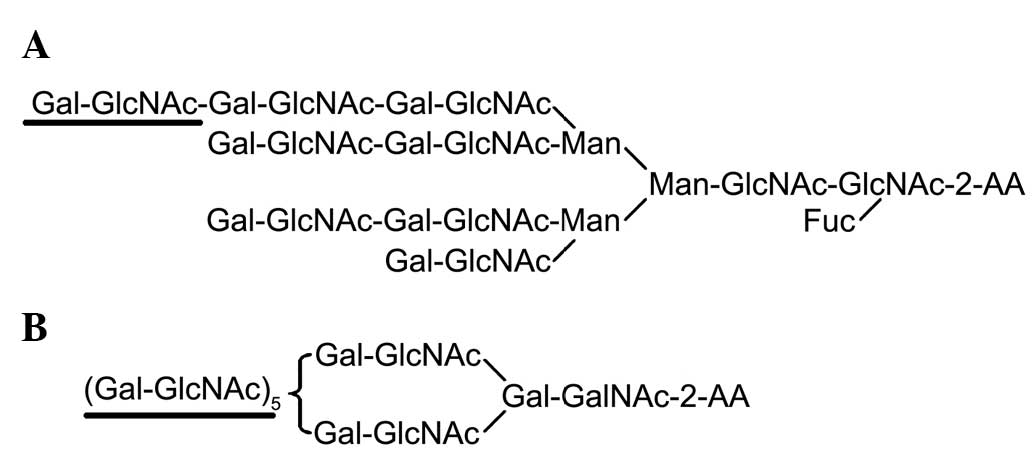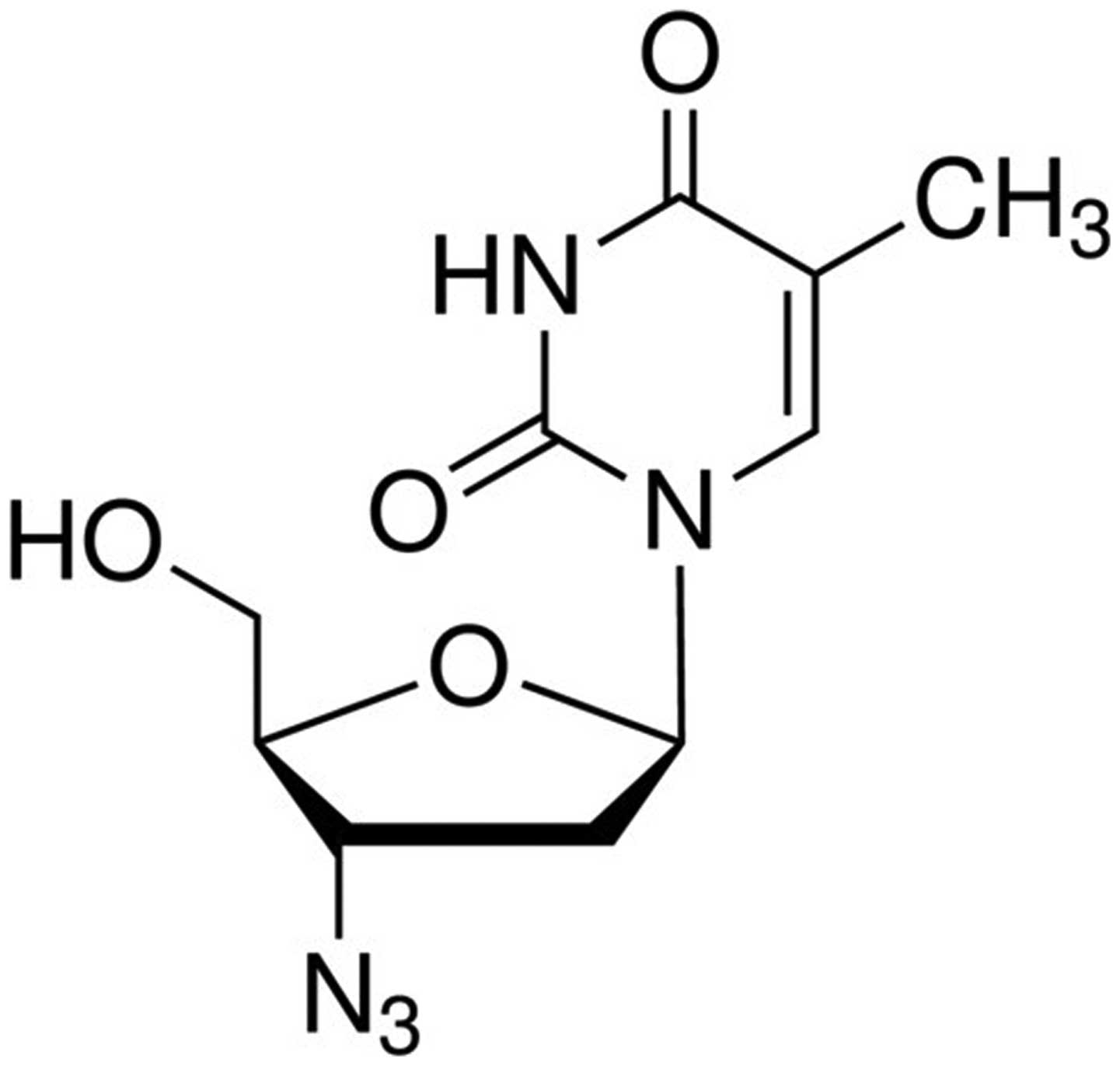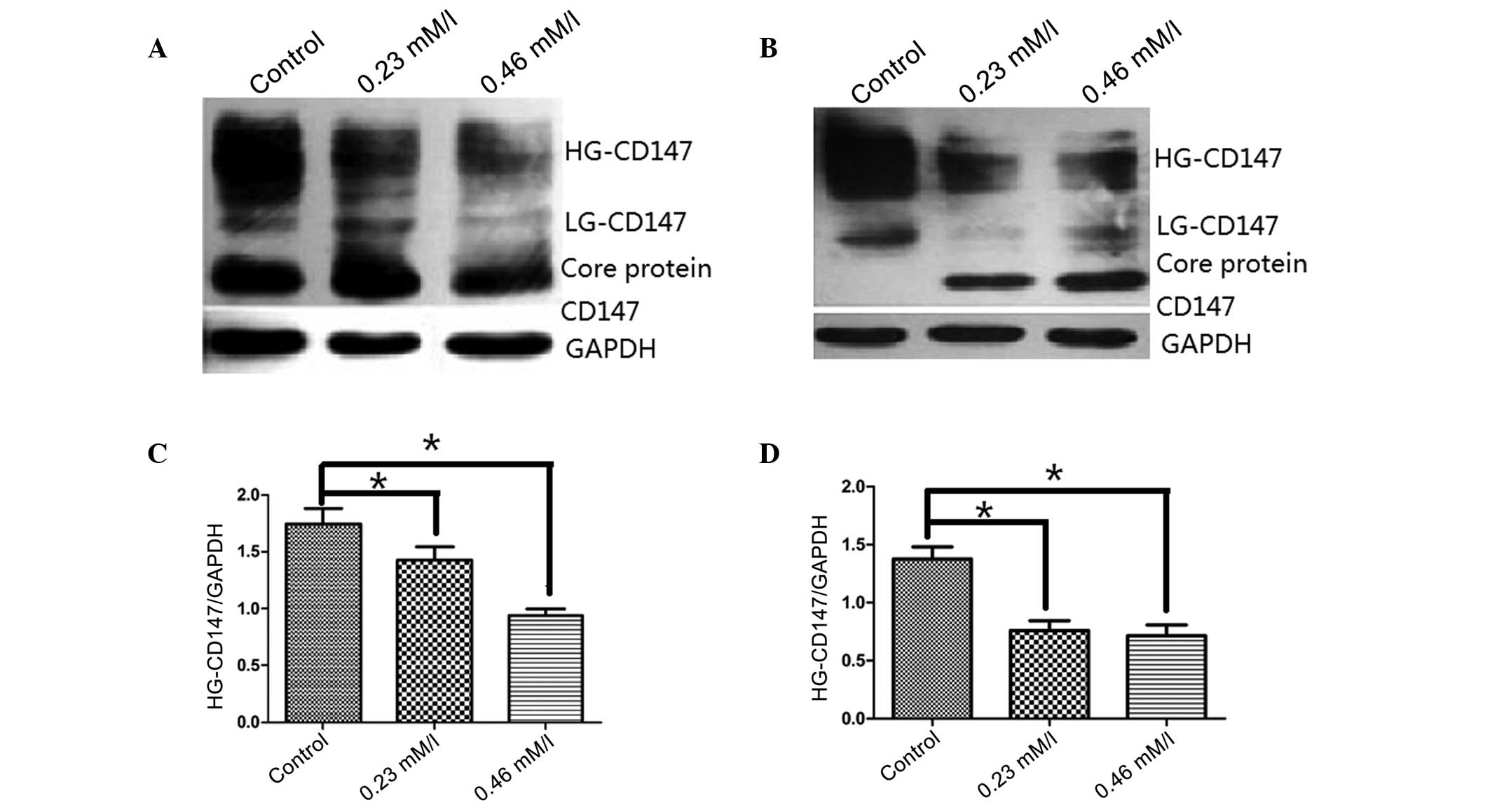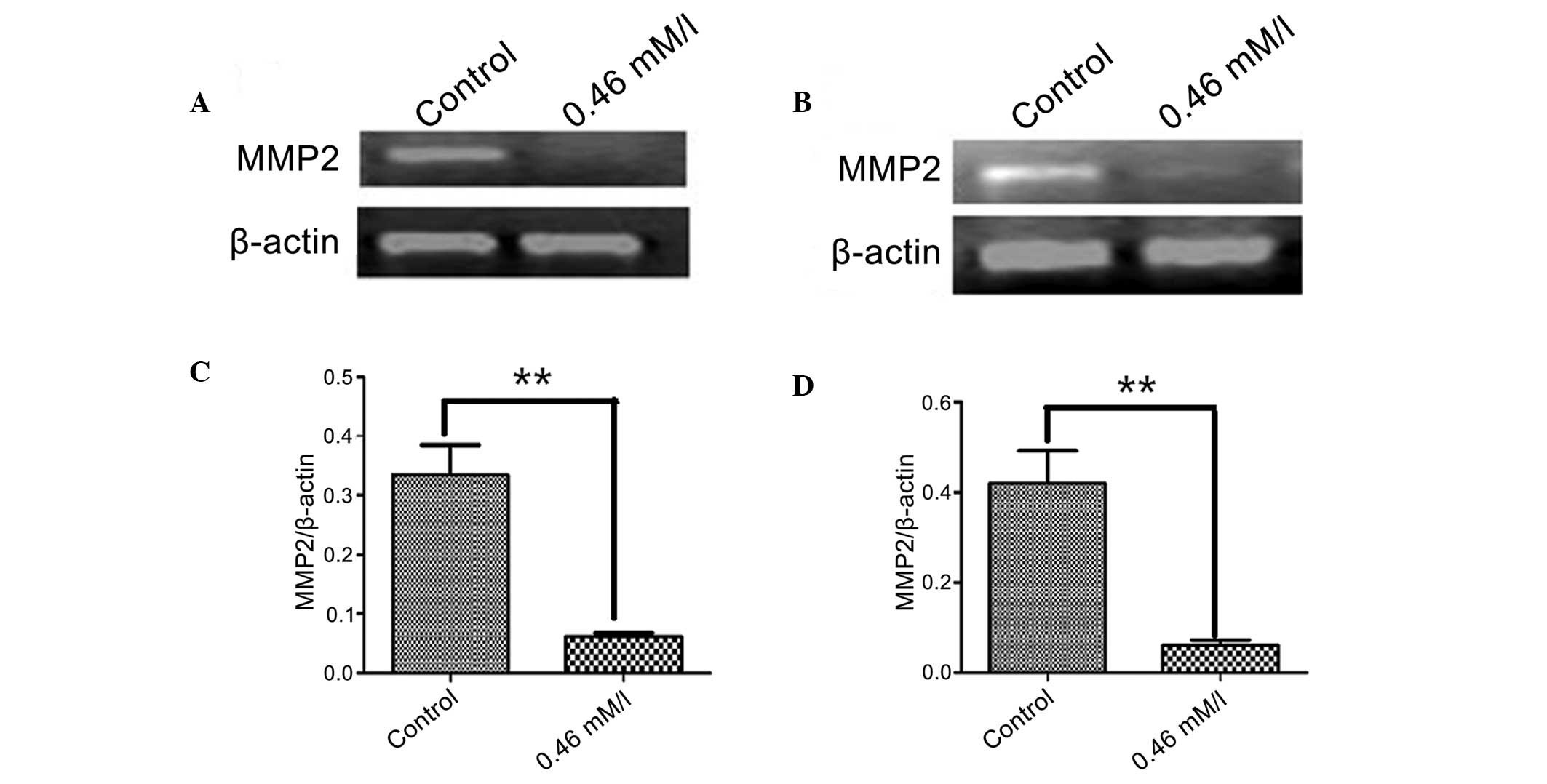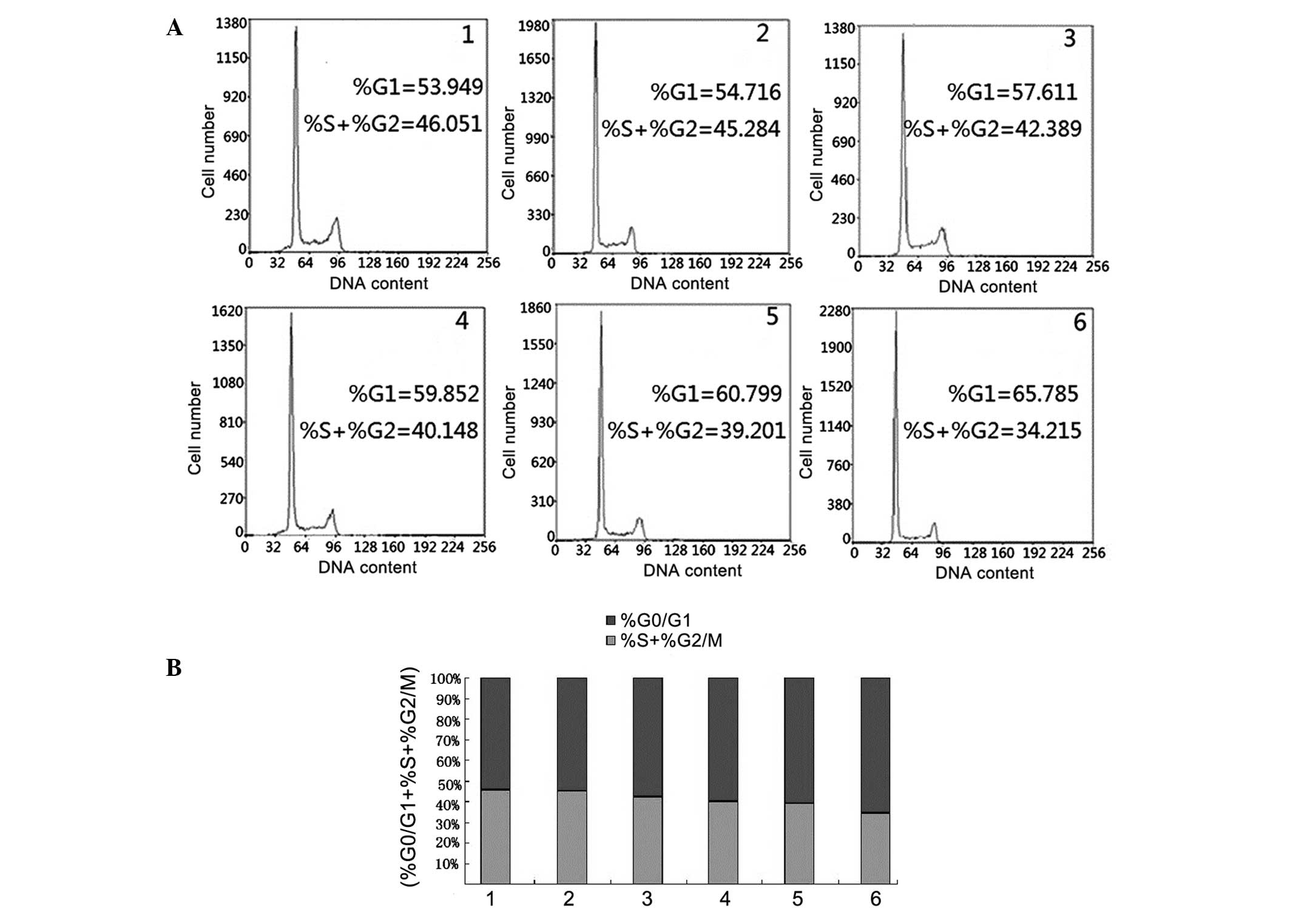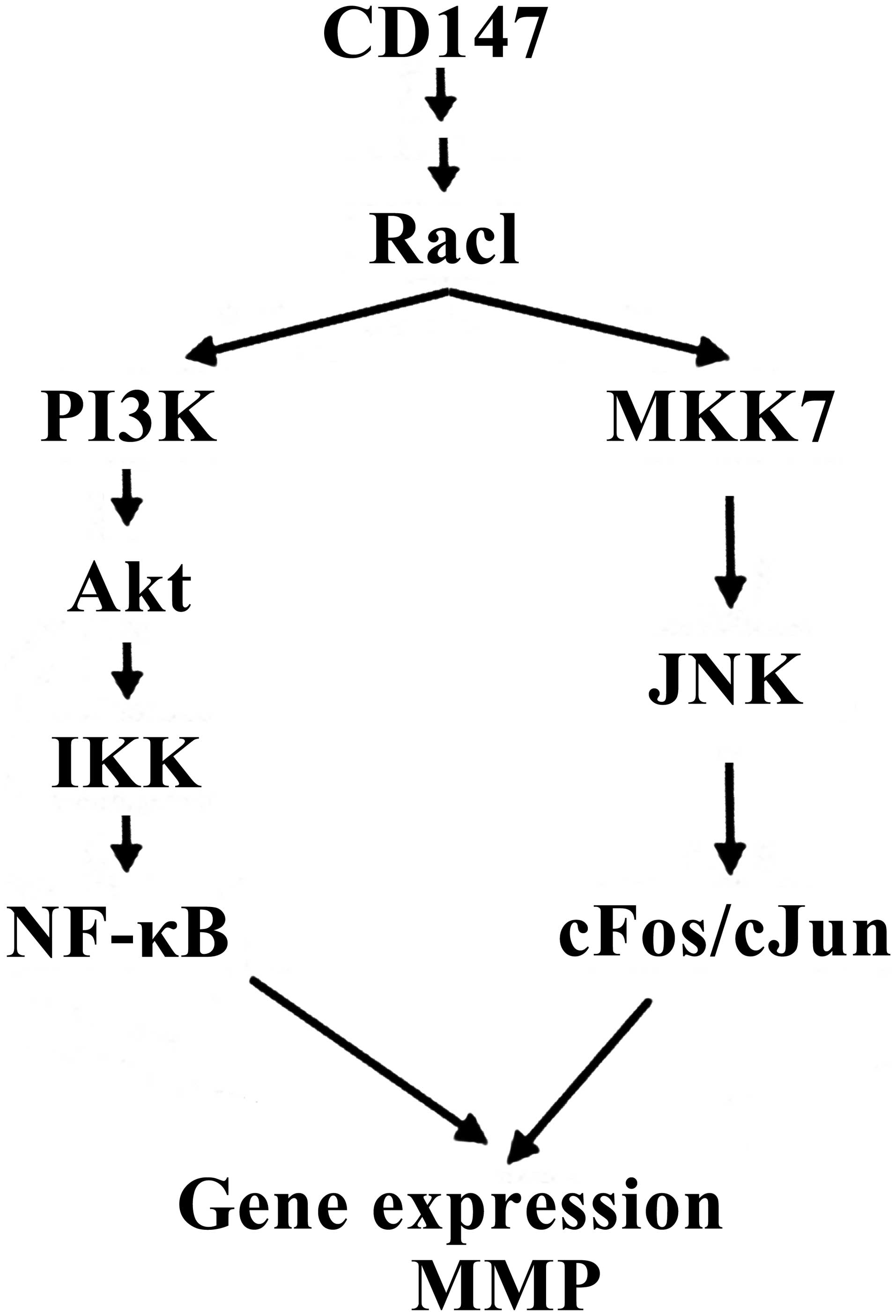3'-Azidothymidine may potently inhibit the biosynthesis of polylactosamine chains on highly glycosylated-CD147 and reduce matrix metalloproteinase-2 expression in SGC-7901 and U251 cells
- Authors:
- Published online on: January 22, 2015 https://doi.org/10.3892/mmr.2015.3241
- Pages: 4713-4719
Abstract
Introduction
Glycosylation is one of the most frequently occurring post-translational modifications of proteins and is suggested to be involved in the regulation of a variety of biological and physical processes, including the secretion, stability, folding and solubility of proteins (1). It has also been observed that the majority of proteins in the serum and the plasma membrane are glycosylated (2). In addition, several previous studies have suggested that aberrant glycosylation of cell surface glycoproteins results in significant alterations in the invasive and metastatic abilities of cancer cells (3,4). For example, the synthesis of polylactosamine chains in colon cancer cells has been demonstrated to be associated with metastasis (5).
Polylactosamine is a unique glycan composed of tandem repeating units of Galβ1-4GlcNAc at the nonreducing terminal (Fig. 1). A previous study observed that polylactosamine-type N-glycans were highly expressed in certain types of cancer cells, including U937 (histiocytic lymphoma), ACHN (human kidney glandular cancer), MKN45 (human gastric cancer), A549 (human lung cancer) and Jurkat cells (acute T-cell leukemia) cell lines (6). Togayachi et al (7) reported that the polylactosamine residues on glycoproteins influenced basal levels of lymphocyte and macrophage activation. Additionally, 24 glycoproteins that possess polylactosamine-type N-glycans have been demonstrated to be present in malignant cells (8).
Cluster of differentiation 147 (CD147), which is also termed Basigin or extracellular matrix metalloproteinase inducer (EMMPRIN), is a glycoprotein that carries polylactosamine on its N-glycosylation sites (9). CD147 is a transmembrane glycoprotein and its extracellular region contains three N-linked glycosylation sites (Asn44, Asn152 and Asn186), which make similar contributions to form the highly and lowly glycosylated forms (HG- and LG-CD147, respectively). The present study demonstrated that LG-CD147 contains a series of high-mannose structures and HG-CD147 contains complex-type N-linked glycans, including β1,6-branched polylactosamine (9). LG-CD147 does not self-aggregate and is not able to induce the production of MMPs, whereas HG-CD147 molecules have been reported to self-aggregate and activate MMP production in tumor cells (9,10). MMP2 has been demonstrated to degrade and destroy the extracellular matrix and basement membrane close to the tumor surface, which aids in the infiltration of tumor cells into surrounding tissues, and promotes tumor cell invasion and metastasis. CD147 is present in tissues with increased MMP expression levels, which suggests that CD147-mediated MMP induction may be involved in the physiological or pathological mechanisms of cancer progression (11,12).
Previous studies have demonstrated that 3′-azidothymidine (AZT; Fig. 2) inhibits the biosynthesis of β1,6-branched N-linked oligosaccharides and polylactosamine chains in cells (13,14). Additional studies have observed that glycosyltransferase β3GnT8 was involved in the synthesis of the polylactosamine chains on the β1,6-branched N-glycans, and influenced the invasion and growth of gastric cancer cells by regulating the expression levels of MMP2 (4,15). However, it remains unclear whether the β1,6-branched polylactosamine chains are critical in this mechanism. Therefore, in the present study, two different tumor cell lines were treated with various concentrations of AZT, the expression levels of HG-CD147 and MMP2 were measured, and the cell cycle was analyzed to investigate cell proliferation in order to elucidate how the β1,6-branched polylactosamine on HG-CD147 may affect MMP2 expression levels and cell proliferation.
Materials and methods
Materials
The U251 human glioma cell line was obtained from the American Type Culture Collection (Manassas, VA, USA). The SGC-7901 human gastric cancer cells were obtained from the Institute of Biochemistry and Cell Biology, Chinese Academy of Science (Shanghai, China). Goat polyclonal anti-CD147 antibody (cat. no. sc-9753) was purchased from Santa Cruz Biotechnology, Inc. (Santa Cruz, CA, USA) and the mouse polyclonal anti-β-actin antibody (cat. no. AA-128-1), and anti-rabbit-horseradish peroxidase (HRP), anti-goat-HRP and anti-mouse-HRP secondary antibodies were purchased from Beyotime Institute of Biotechnology (Haimen, China). AZT was purchased from Sigma-Aldrich (St. Louis, MO, USA). Other reagents were commercially available in China.
Cell culture
The U251 cells were cultured in Dulbecco’s modified Eagle’s medium (Gibco Life Technologies, Carlsbad, CA, USA) supplemented with 10% fetal bovine serum (FBS). The SGC-7901 cells were cultured in RPMI-1640 (Gibco Life Technologies) medium supplemented with 10% FBS (Gibco Life Technologies). The two cell lines were cultured in a humidified atmosphere with 5% CO2 at 37°C.
Semi-quantitative reverse transcription polymerase chain reaction (RT-PCR)
Total RNA was extracted from the two cancer cell lines using TRIzol (Invitrogen Life Technologies, Carlsbad, CA, USA), in accordance with the manufacturer’s instructions. Complementary DNA (cDNA) was generated from total RNA using M-MLV reverse transcriptase (Thermo Fisher Scientific, Waltham, MA, USA). The PCR reaction mix consisted of 12.5 μl Easy Taq PCR Supermix (Beijing Transgen Biotech Co., Ltd., Beijing, China), 0.5 μl forward primer, 0.5 μl reverse primer, 1 μl cDNA and 0.5 μl ddH2O. The PCR cycling (Veriti® 96-well Thermal cycler; Applied Biosystems, Foster City, CA, USA) conditions were as follows: Initial denaturing at 95°C for 5 min, 30 cycles of denaturing at 95°C for 30 sec, annealing at 60°C for 45 sec, elongation at 72°C for 1 min and at 72°C for 10 min. The annealing temperature of MMP2 was 55°C and of β-actin was 53°C. Specific primers (Invitrogen Life Technologies) used for the genes and expected product sizes were as follows: Forward: 5′-AAC CCT CAG AGC CAC CCC TA-3′ and reverse: 5′-GTG CAT ACA AAG CAA ACT GC-3′ (286 bp) for MMP-2; and forward: 5′-GAG CTA CGA GCT GCC TGA CG-3′ and reverse: 5′-CCT AGA AGC ATT TGC GGT GG-3′ (416 bp) for β-actin. The PCR products were separated using electrophoresis on 10 g/l agarose gels and visualized using ethidium bromide staining.
Western blot analysis
Protein was extracted from cell lysates using ice-cold radio immunoprecipitation assay lysis buffer (50 mmol/l Tris (pH 7.4), 150 mmol/l sodium chloride, 1% NP-40, 0.5% sodium deoxycholate, 0.1% SDS, 1 mM sodium or thovanadate, 10 mM sodium fluoride, 5 mM EDTA, 10 μg/ml leupeptin; Beyotime Institute of Biotechnology) supplemented with 1 mmol/l phenylmethanesulfonyl fluoride (Beyotime Institute of Biotechnology). The protein concentration in cell lysates was determined using a protein assay kit (Nanjing KeyGen Biotech Co., Ltd., Nanjing, China). An equal quantity of protein from each sample was mixed with 4X loading buffer (containing 250 mmmol/l Tris-hydrochloric acid, 40% glycerol, 5% SDS, 0.005% bromophenol blue and 100 mmol/l dithiothreitol; Beyotime Institute of Biotechnology) and was denatured for 5 min at 100°C. Total proteins were then separated by SDS-PAGE (10% acrylamide gel) and transferred onto polyvinylidene fluoride membranes (Pall Corporation, Beijing, China) that had been pretreated with methanol. The membranes were then blocked for 1 h at room temperature in PBST [phosphate-buffered saline (PBS) with 0.05% Tween-20] (Gibco Life Technologies) containing 5% skimmed milk. The proteins were analyzed using the specific antibodies mentioned. The blots were incubated overnight at 4°C with the primary antibodies against CD147 (1:300) and β-actin (1:1,000). Subsequent to removal of the primary antibodies, the blots were then incubated for 1 h at room temperature with goat anti-rabbit, donkey anti-goat or rabbit anti-mouse HRP-conjugated secondary antibodies (1:1,000). ECL Plus Detection system (Beyotime Institute of Biotechnology) was used according to the manufacturer’s instructions to detect chemiluminescence.
Regulation of CD147 and MMP2 expression by various concentrations of AZT
The U251 and SGC-7901 cells were seeded into a 6-well plate and incubated overnight. Subsequently, the cells were washed once with PBS and cultured for 48 h in fresh culture medium in the absence or presence of various concentrations of AZT (0, 0.23 and 0.46 mmol/l). The cells were then harvested, and western blotting and RT-PCR analysis were conducted to measure CD147 and MMP2 expression.
Analysis of the cell cycle by flow cytometry
The SGC-7901 cells were plated at a density of 5×105 cells/well on 6-well plates and incubated in serum-free medium for 24 h in order to arrest the cells at the same stage of the cell cycle. Subsequent to exposure to various concentrations of AZT for 24 h, the cells were harvested and fixed with cold 70% ethanol overnight. The fixed cells were incubated in PBS containing 50 μg/ml RNase A (Sigma-Aldrich), 0.25% Triton X-100 (Sigma-Aldrich) and 0.1 mmol/l EDTA (Thermo Fisher Scientific) for 30 min at 37°C. Propidium iodide (PI) was added to the cell suspension at a concentration of 100 μg/ml and incubated for 15 min at room temperature in the dark. The cell cycle was analyzed using flow cytometry with Cell Quest Pro software (FACScan; BD Biosciences, San Jose, CA, USA).
Statistical analysis
All results are expressed as the mean ± standard deviation. Statistical significance was evaluated with data from three independent experiments using Student’s t-test. Statistical analyses were conducted using SPSS version 19.0 (SPSS Inc., Chicago, IL, USA). P<0.05 was considered to indicate a statistically significant difference.
Results
Regulation of N-glycosylation on CD147 by AZT in SGC-7901 and U251 cells
To examine the effect of AZT on CD147 N-glycosylation, the two cell lines were treated with various AZT concentrations for 48 h. Proteins from these treated cell lines were assessed using western blot analysis. As demonstrated in Fig. 3, CD147 was clearly expressed in SGC-7901 and U251 cells; however, subsequent to treatment with AZT (0.23 and 0.46 mmol/l) the glycosylation level of HG-CD147 located at 45–65 kDa was significantly reduced compared with the controls in the two cell lines (P<0.05). Furthermore, the glycosylation level of LG-CD147 was also significantly reduced in the treated cells, as compared with the two control cell lines. The results suggest that AZT may inhibit the biosynthesis of polylactosamine chains on N-glycans of CD147.
Regulation of MMP2 expression by AZT in SGC-7901 and U251 cells
To examine the effect of AZT on the mRNA levels of MMP2, the two cell lines were treated with 0.46 mmol/l AZT for 48 h and RT-PCR analysis was conducted. As demonstrated by agarose gel electrophoresis in Fig. 4, following AZT treatment in SGC-7901 and U251 cells, MMP2 expression was almost eradicated, compared with the control group (P<0.01). These results indicate that AZT may also inhibit the expression of MMP2.
Cell cycle analysis
To investigate the effect of AZT treatment on cell cycle distribution in SGC-7901 cells, the cells were treated with various concentrations of AZT (0.23, 0.46, 0.69, 0.92 and 1.15 mmol/l) for 24 h and subjected to flow cytometric analysis subsequent to staining of the chromosomal DNA with PI. As demonstrated in Fig. 5, AZT treatment altered the cell cycle distribution of SGC-7901 cells. The proliferation index [%S+%G2/M)/(%G0/G1+%S+G2/M)] values for G1 phase in the AZT-treated cells was 53.949, 54.716, 57.611, 59.852, 60.799 and 65.785% for the different AZT concentrations, respectively. These results indicated that the percentage of AZT-treated cells in the G1 phase increased and the number of cells in the S, G2 and M phases reduced in a dose-dependent manner. This suggests that AZT may arrest the cell cycle in the G1 phase to inhibit cell proliferation.
Discussion
It has been reported that AZT may markedly alter the profile of N-linked oligosaccharides in the K562 erythroleukemia cell line and the SKSSK-MEL-30 melanoma cell line (13). A previous study demonstrated that in these cell lines, AZT treatment markedly reduced the synthesis of highly branched complex oligosaccharides and polylactosamine chains (poly-LacNAc) (14). Poly-LacNAc contains linear LacNAc (Galβ1-4GlcNAcβ1-3) N repeats, which are formed by the addition of galactose (Gal) to terminal GlcNAc residues in the Golgi complex (16). However, it has been reported that the mechanism of AZT-mediated inhibition of poly-LacNAc synthesis is via the inhibition of UDP-GalNAc movement into the Golgi complex and blocking the addition of LacNAc repeats. In addition, AZT is also reported to block the formation of the GlcNAc-β-1,6-Man branch, a preferred initiation site for poly-LacNAc synthesis (17,18).
Alterations in N-linked glycans are associated with the progression of cancer. Of particular importance in tumor growth and invasion is the synthesis of complex N-linked oligosaccharides containing long polylactosamine chains (19). These outer branch modifications are suggested to be critical in cell-cell recognition and communication events, due to the modulation of the structural and the functional properties of carrier glycoproteins associated with cancer progression (20). Highly branched complex glycan chains, for example the polylactosamine extension, appear to be important for the oncogenic phenotype of tumor cells (21). In addition, polylactosamine side chains have been suggested to serve critical roles in the adhesive properties of tumorigenic cells (22). Saitoh et al (4) demonstrated that lysosomal associated membrane proteins isolated from a highly metastatic cancer cell line contained markedly more polylactosamine side chains than one with low metastatic activity. From this, it was concluded that increased quantities of these side chains are characteristic of the metastatic phenotype.
The glycoprotein HG-CD147 is a key carrier of β1,6-branched polylactosamine sugars on N-glycans in tumor cells (9). β1,3-N-acetylglucosaminyltransferases (β3GnTs) may catalyze the initiation and elongation of polylactosamine chains on O-glycans, N-glycans and glycolipids (17,23,24). A previous study identified that β3GnT8 was involved in the biosynthesis of β1,6-branched polylactosamine sugars on N-glycans in vitro and it may alter the glycosylation of HG-CD147 and further regulate the metastatic potential of colorectal cancer cells (25).
CD147 is composed of two domains in the extracellular region, a single transmembrane domain and a short cytoplasmic domain containing 39 amino acids. The extracellular region contains three Asn glycosylation sites; however, the glycan portion of the molecule differs depending on the source of CD147. CD147 glycosylation has been previously demonstrated to determine its ability to activate MMPs. Purified deglycosylated CD147 and LG-CD147 failed to induce MMP activity, whereas HG-CD147 effectively induced MMP activity. Since the glycosylated regions of CD147 serve an important role in MMP expression and HG-CD147 contains multiple β1,6-branched polylactosamine sugars, which are catalyzed by β3GnT8 and may regulate the metastatic potential of colorectal cancer cells. Therefore, AZT was used in the present study to examine whether the β1,6-branched polylactosamine sugars on CD147 are important in SGC-7901 and U251 cells.
Subsequent to treatment of SGC-7901 and U251 cells with AZT, it was observed using western blot analysis that the quantity of N-glycans of HG-CD147 was reduced, compared with that in the control group (P<0.05; Fig. 3). This result indicated that the N-glycans of CD147 contain β1,6-branched polylactosamine sugars and may be inhibited by AZT. As HG-CD147 regulates MMP expression, AZT may additionally affect MMP expression in SGC-7901 and U251 cells. MMPs are a class of molecules that have been demonstrated to be integral to tumor progression, facilitating cell migration and invasion through their ability to degrade the extracellular matrix. As shown in Fig. 4, MMP2 expression was almost eradicated compared with the control group subsequent to treatment with AZT (P<0.01), it is thus suggested that AZT may prevent the expression of MMP2. In addition, the cell cycle distribution of SGC-7901 cells was altered by AZT, with a dose-dependent increase in the percentage of cells in the G1 phase, indicating that AZT may arrest the cell cycle in G1 phase to inhibit cell proliferation (Fig. 5). These results suggest that AZT may inhibit the biosynthesis of polylactosamine chains on CD147 and thus affect MMP2 expression and cell cycle progression in SGC-7901 and U251 tumor cells.
It has been reported that CD147 may activate several transcription factors, including activator protein 1 (AP-1) and nuclear factor-κB (NF-κB), which leads to the MMP-inducing activity of CD147 (25). For example, MMP3, 7, 9, 10, 12 and 13 contain a minimum of one AP-1 binding site in their proximal promoter region (17). MMP2, 3, 9 and 14 are also NF-κB responsive in a cell- and stimulus-specific manner (26–28). In addition, CD147 may also induce IκB kinase (IKK) activation in the PI3K/Akt-dependent signaling pathway and induce c-Jun N-terminal kinase-dependent c-Jun activation via the mitogen-activated protein kinase 7 (MKK7) signaling pathway. Thus, a previous study demonstrated that CD147 induced MMP expression predominantly via PI3K/Akt/IKK-dependent NF-κB and MKK7/JNK-dependent AP-1 signal transduction pathways (25) (Fig. 6). Therefore, it was hypothesized that the AZT-mediated inhibition of MMP2 expression by reducing CD147 N-glycans in the present study, may be via the above two pathways.
In conclusion, AZT may inhibit the biosynthesis of polylactosamine chains on CD147 in tumor cells. The glycoprotein CD147 is hypothesized to be an upstream modulator inducing MMP production in tumor cells and AZT may be effective therapeutically as an antineoplastic drug in certain types of cancer by altering the glycosylation levels of HG-CD147.
Acknowledgments
The current study was supported by the National Natural Science Foundation of China (grant no. 31170772) and Suzhou Municipal Natural Science Foundation (grant no. SY201208).
References
|
Kato T, Suzuki M, Murata T and Park EY: The effects of N-glycosylation sites and the N-terminal region on the biological function of beta1,3-N-acetylglucosaminyltransferase 2 and its secretion. Biochem Biophys Res Commun. 329:699–705. 2005. View Article : Google Scholar : PubMed/NCBI | |
|
Narimatsu H: Human glycogene cloning: focus on beta 3-glycosyltransferase and beta 4-glycosyltransferase families. Curr Opin Struct Biol. 16:567–575. 2006. View Article : Google Scholar : PubMed/NCBI | |
|
Hakomori S: Glycosylation defining cancer malignancy: new wine in an old bottle. Proc Natl Acad Sci USA. 99:10231–10233. 2002. View Article : Google Scholar : PubMed/NCBI | |
|
Saitoh O, Wang WC, Lotan R and Fukuda M: Differential glycosylation and cell surface expression of lysosomal membrane glycoproteins in sublines of a human colon cancer exhibiting distinct metastatic potentials. J Biol Chem. 267:5700–5711. 1992.PubMed/NCBI | |
|
Kinoshita M, Mitsui Y, Kakoi N, Yamada K, Hayakawa T and Kakehi K: Common glycoproteins expressing polylactosamine-type glycans on matched patient primary and metastatic melanoma cells show different glycan profiles. J Proteome Res. 2013.PubMed/NCBI | |
|
Mitsui Y, Yamada K, Hara S, Kinoshita M, Hayakawa T and Kakehi K: Comparative studies on glycoproteins expressing polylactosamine-type N-glycans in cancer cells. J Pharm Biomed Anal. 70:718–726. 2012. View Article : Google Scholar : PubMed/NCBI | |
|
Togayachi A, Kozono Y, Ishida H, et al: Polylactosamine on glycoproteins influences basal levels of lymphocyte and macrophage activation. Proc Natl Acad Sci USA. 104:15829–15834. 2007. View Article : Google Scholar : PubMed/NCBI | |
|
Tang W, Chang SB and Hemler ME: Links between CD147 function, glycosylation, and caveolin-1. Mol Biol Cell. 15:4043–4050. 2004. View Article : Google Scholar : PubMed/NCBI | |
|
Huang W, Luo WJ, Zhu P, et al: Modulation of CD147-induced matrix metalloproteinase activity: role of CD147 N-glycosylation. Biochem J. 449:437–448. 2013. View Article : Google Scholar | |
|
Gabison EE, Hoang-Xuan T, Mauviel A and Menashi S: EMMPRIN/CD147, an MMP modulator in cancer, development and tissue repair. Biochimie. 87:361–368. 2005. View Article : Google Scholar : PubMed/NCBI | |
|
Agrawal SM and Yong VW: The many faces of EMMPRIN - roles in neuroinflammation. Biochim Biophys Acta. 1812:213–219. 2011. View Article : Google Scholar | |
|
Hall ET, Yan JP, Melançon P and Kuchta RD: 3′-Azido-3′-deoxythymidine potently inhibits protein glycosylation. A novel mechanism for AZT cytotoxicity. J Biol Chem. 269:14355–14358. 1994.PubMed/NCBI | |
|
Steet RA, Melancon P and Kuchta RD: 3′-Azidothymidine potently inhibits the biosynthesis of highly branched N-linked oligosaccharides and poly-N-acetyllactosamine chains in cells. J Biol Chem. 275:26812–26820. 2000.PubMed/NCBI | |
|
Liu Z, Shen L, Xu L, Sun X, Zhou J and Wu S: Down-regulation of β-1,3-N-acetylglucosaminyltransferase-8 by siRNA inhibits the growth of human gastric cancer. Mol Med Rep. 4:497–503. 2011.PubMed/NCBI | |
|
van den Eijnden DH, Koenderman AH and Schiphorst WE: Biosynthesis of blood group i-active polylactosaminoglycans. Partial purification and properties of an UDP-GlcNAc:N-acetyllactosaminide beta 1 - 3-N-acetylglucos aminyltransferase from Novikoff tumor cell ascites fluid. J Biol Chem. 263:12461–12471. 1988.PubMed/NCBI | |
|
Ishida H, Togayachi A, Sakai T, et al: A novel beta1,3-N-acetylglucosaminyltransferase (beta3Gn-T8), which synthesizes poly-N-acetyllactosamine, is dramatically upregulated in colon cancer. FEBS Lett. 579:71–78. 2005. View Article : Google Scholar | |
|
Do KY and Cummings RD: 2,6-branched mannose and the regulation of poly-N-acetyllactosamine biosynthesis in N-linked oligosaccharides of Chinese hamster ovary cells. J Biol Chem. 268:22028–22035. 1993.PubMed/NCBI | |
|
Hakomori S: Tumor malignancy defined by aberrant glycosylation and sphingo(glyco)lipid metabolism. Cancer Res. 56:5309–5318. 1996.PubMed/NCBI | |
|
Pierce M, Buckhaults P, Chen L and Fregien N: Regulation of N-acetylglucosaminyltransferase V and Asn-linked oligosaccharide beta(1,6) branching by a growth factor signaling pathway and effects on cell adhesion and metastatic potential. Glycoconj J. 14:623–630. 1997. View Article : Google Scholar : PubMed/NCBI | |
|
Datti A, Orlacchio A, Siminovitch KA and Dennis JW: A coupled assay for UDP-GlcNAc:Gal beta 1-3GalNAc-R beta 1,6-N-acetylglucosaminyltransferase (GlcNAc to GalNAc). Anal Biochem. 206:262–266. 1992. View Article : Google Scholar : PubMed/NCBI | |
|
Sawada R, Lowe JB and Fukuda M: E-selectin-dependent adhesion efficiency of colonic carcinoma cells is increased by genetic manipulation of their cell surface lysosomal membrane glycoprotein-1 expression levels. J Biol Chem. 268:12675–12681. 1993.PubMed/NCBI | |
|
Krishnan V, Bane SM, Kawle PD, Naresh KN and Kalraiya RD: Altered melanoma cell surface glycosylation mediates organ specific adhesion and metastasis via lectin receptors on the lung vascular endothelium. Clin Exp Metastasis. 22:11–24. 2005. View Article : Google Scholar : PubMed/NCBI | |
|
Ishida H, Togayachi A, Sakai T, et al: A novel beta1,3-N-acetyl-glucosaminyltransferase (beta3Gn-T8), which synthesizes poly-N-acetyllactosamine, is dramatically upregulated in colon cancer. FEBS Lett. 579:71–78. 2005. View Article : Google Scholar | |
|
Ni J, Jiang Z, Shen L, et al: β3GnT8 regulates the metastatic potential of colorectal carcinoma cells by altering the glycosylation of CD147. Oncol Rep. 31:1795–1801. 2014.PubMed/NCBI | |
|
Venkatesan B, Valente AJ, Prabhu SD, Shanmugam P, Delafontaine P and Chandrasekar B: EMMPRIN activates multiple transcription factors in cardiomyocytes, and induces interleukin-18 expression via Rac1-dependent PI3K/Akt/IKK/NF-kappaB and MKK7/JNK/AP-1 signaling. J Mol Cell Cardiol. 49:655–663. 2010. View Article : Google Scholar : PubMed/NCBI | |
|
Li G, Zhang Y, Qian Y, Zhang H, et al: Interleukin-17A promotes rheumatoid arthritis synoviocytes migration and invasion under hypoxia by increasing MMP2 and MMP9 expression through NF-κB/HIF-1α pathway. Mol Immunol. 53:227–236. 2013. View Article : Google Scholar | |
|
Sun P, Mu Y and Zhang S: A novel NF-κB/MMP-3 signal pathway involves in the aggressivity of glioma promoted by Bmi-1. Tumour Biol. 35:12721–12727. 2014. View Article : Google Scholar : PubMed/NCBI | |
|
Han YP, Tuan TL, Wu H, Hughes and Garner WL: TNF-alpha stimulates activation of pro-MMP2 in human skin through NF-(kappa)B mediated induction of MT1-MMP. J Cell Sci. 114:131–139. 2001. |



